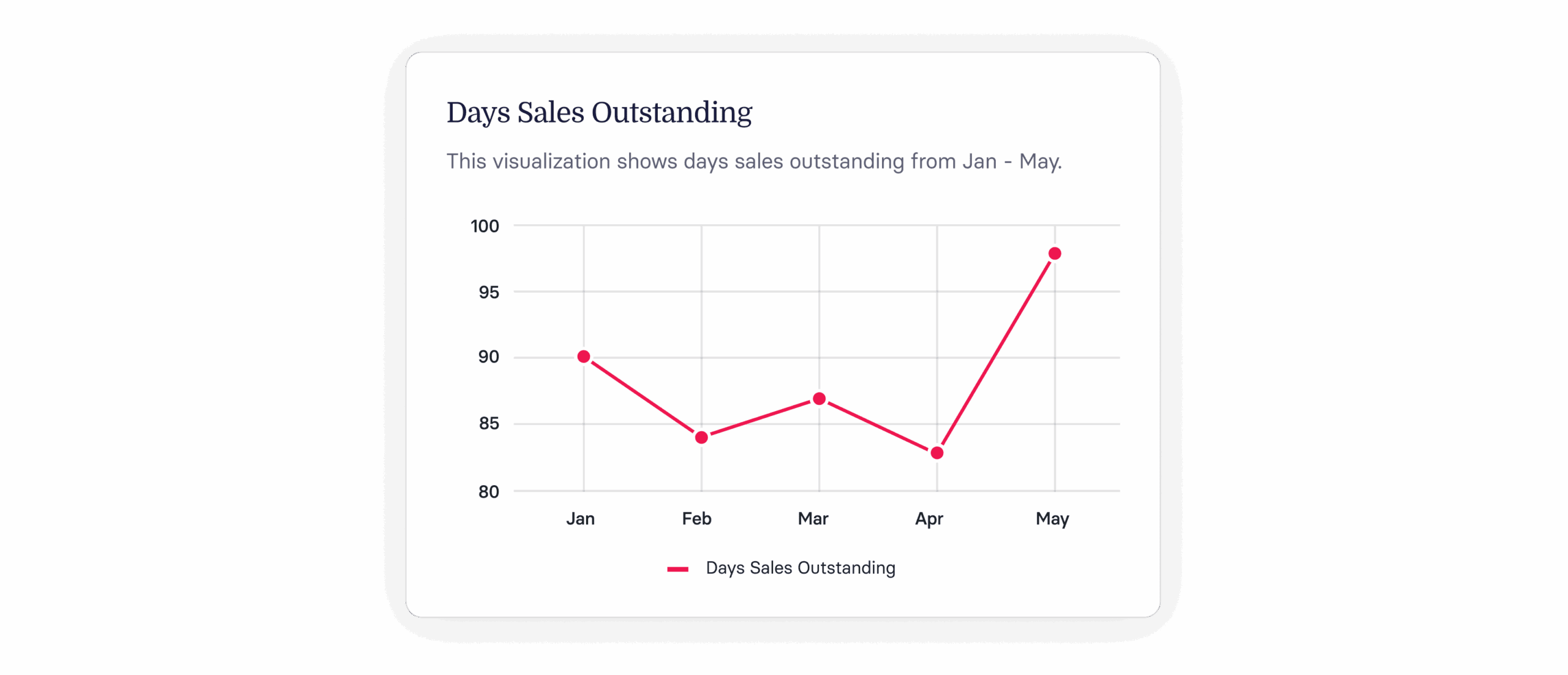Days sales outstanding (DSO) is a crucial financial metric that measures the average time it takes for a company to collect payments after a sale
What is days sales outstanding?
Days sales outstanding (DSO) is a financial performance metric that measures the average number of days it takes a company to collect payment after making a sale.
Also known as “days to collect,” this key performance indicator (KPI) helps finance and accounting leaders better understand their cash conversion cycle, improve cash flow, and manage accounts receivable. Tracking your average DSO over time can make it easier to monitor liquidity and spot changes in working capital.
<<Download the SaaS metrics cheat sheet.>>

Days sales outstanding formula
The formula for calculating days sales outstanding (DSO) is straightforward: divide your average accounts receivable balance by revenue for a given period, then multiply by the number of days in that period.

Here’s how that looks in practice. Let’s say your company generated $1 million in revenue over the past year and had an average accounts receivable balance of $150,000. You’d calculate DSO like this:
- ($150,000 / $1 million) × 365 days = approximately 55 days
If your payment terms are net-60, a 55-day DSO might feel on target. But if you’re expecting payment within 30 days, a 55-day average is a red flag worth investigating.
The importance of monitoring DSO for SaaS companies
Monitoring DSO is essential for the financial health of B2B SaaS startups. Being proactive about tracking days to collect helps you identify cash flow issues early—before they start to affect your team’s ability to operate efficiently.
If your accounts receivable balance doesn’t align with the cash needed to support your operations, you might struggle to keep pace with growth. Paired with metrics like accounts receivable aging, DSO gives finance leaders better visibility into working capital—and supports a “cash is king” mindset.
In general, tracking DSO offers four key benefits:
Improve cash flow management
Spot seasonal or trend-based increases in DSO and work with accounting and customer success to troubleshoot and resolve them.
Assess customer credit risks
Changes in DSO can highlight challenges your customers are facing or signal inefficiencies in your collections process.
Benchmark your performance
Comparing your DSO to internal goals and broader SaaS benchmarks can help you evaluate your performance in context—without over-indexing on competitors.
Optimize billing and collections
Regular monitoring helps you pinpoint inefficiencies in your invoicing and collections process, enabling faster payments and steadier cash flow.
<<Get the 10 SaaS metrics you didn’t know you needed ebook.>>
Days sales outstanding vs. average collection period
he difference between days sales outstanding (DSO) and average collection period (ACP) depends on your industry. Some use the terms interchangeably, while others point to subtle distinctions in how they’re calculated.
In the SaaS world, DSO and ACP are effectively the same. That’s because SaaS companies don’t typically deal with cash sales the way consumer goods or retail businesses do.
Here’s how ACP is calculated:
- (Accounts receivable balance ÷ net credit sales) × number of days in the period
With DSO, you generally divide accounts receivable by total revenue. In industries selling physical goods, the two metrics may diverge because net credit sales exclude cash transactions—and often factor in things like returns, warranty claims, or recalls.
But in SaaS, those variables are usually minimal. Your inputs for DSO and ACP should be closely aligned.
Recommended For Further Reading
What does a high DSO mean?
A high days sales outstanding (DSO) means it’s taking longer than expected to collect payment after a sale—something that can impact your company’s cash flow and financial stability. For B2B SaaS companies, it’s important to understand what a rising DSO might be signaling:
- Strained cash flow: outstanding invoices tie up cash that could be used for operations or growth initiatives.
- Inefficient collections process: a high DSO may point to issues in your invoicing or follow-up processes—such as manual workflows, lack of automation, or unclear payment terms.
- Customer credit concerns: if customers routinely miss payment deadlines, it could be a sign of credit risk. This might be a good time to revisit your payment policies or adjust credit terms.
What does a low DSO mean?
A low days sales outstanding (DSO) typically signals a healthy accounts receivable process. It means your company collects payments quickly after making a sale—supporting steady cash flow and overall financial stability.
This kind of performance can reflect strong collaboration between sales and customer success, along with clear expectations around payment timing and terms.
Here are a few reasons you might see a lower DSO:
- Efficient billing and collections: prompt invoicing and proactive follow-ups can significantly reduce DSO
- Favorable payment terms: shorter due dates or early payment discounts can encourage customers to pay sooner
- Reliable customer base: working with customers who have strong credit histories and pay on time helps maintain a lower DSO
5 Ways to Lower DSO
Lowering your days sales outstanding (DSO) can have a big impact on cash flow and financial resilience. Here are five strategies B2B SaaS companies can use to drive faster payments:
Offer early payment discounts
Incentivize customers to pay sooner with discounts for upfront or early payments—like a small percentage off if they pay within 10 days.
Automate invoicing and collections
Financial software tools can help streamline billing and send automated reminders, reducing the risk of delayed payments.
Improve customer communication
Keep customers informed about upcoming due dates and any overdue balances. Clear, consistent communication supports strong relationships and on-time payments.
Create clear late payment policies
Outline penalties or interest charges for late payments and include them in your contracts to ensure alignment from day one.
Analyze customer payment history
Digging into payment trends helps you identify customers who regularly pay late—so you can address potential issues before they escalate.
Each of these approaches works better when you’re not bogged down by manual DSO calculations. This is where automation can save time and boost accuracy.
Tracking DSO at a granular level
The standard formula for calculating days sales outstanding (DSO) is a great starting point—but surface-level numbers only tell part of the story. For deeper insight, you’ll want to tailor the calculation to your business.
Here are a few ways to make your DSO tracking more specific:
- Measure the average days to collect for particular customer segments (like enterprise accounts)
- Analyze DSO by product line to identify which offerings lead to faster payments
- Compare collection times across different contract lengths (e.g., one-year vs. two-year deals)
These insights are already in your general ledger and revenue data—you just need the right tools to access them.
Key takeaways
- Days sales outstanding (DSO) is a crucial financial metric that measures the average time it takes for a company to collect payments after a sale
- Lowering your DSO improves cash flow, enhances financial stability, and supports business growth
- Efficient invoicing processes, clear communication, and automation are key strategies to reduce DSO
- By closely tracking DSO, SaaS companies can better assess customer credit risks and benchmark performance against industry standards
Automating DSO tracking with financial software
Unlocking granular insights doesn’t have to mean building complex spreadsheets. Instead of manually gathering data, structuring it, and maintaining formulas in Excel, financial tools can automate the process—saving time and reducing errors.
The right software solution lets you pull in data from any source and build custom metrics without code. Whether you’re tracking DSO by customer segment, product line, or contract type, a flexible interface makes it easy to explore the metrics that matter most to your business.
The more tailored your calculations, the more strategic value you can extract from your data.
But remember—DSO is just one piece of the puzzle. To get a full picture of your collections and financial health, look at related metrics like accounts receivable turnover, AR aging, average days delinquent, and bad debt to sales. Customizing each of these to your business model can uncover more actionable insights.
Days sales outstanding FAQs
What is the difference between DSO and AR?
Accounts receivable (AR) reflects the total dollar amount you’re owed from outstanding invoices. DSO, on the other hand, tells you how many days it takes—on average—to collect that money. AR is a point-in-time balance; DSO provides a time-based perspective on your collections performance.
What does a higher days sales outstanding mean?
A high DSO indicates delays in collecting payments. If you expect to be paid within 30 to 45 days, but your DSO is trending above 60, it’s a signal to dig deeper. Consider partnering with customer success to adjust incentives or communication strategies to help bring payments in faster.
Why calculate days sales outstanding?
DSO helps you assess how efficiently your company is converting sales into cash. It’s a key lever for improving cash flow and identifying where to streamline collections. The more precisely you calculate it, the easier it becomes to spot inefficiencies and drive improvements.

